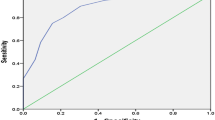Abstract
There have been suggestions that some self-administered questionnaires designed to assess psychiatric disorder tend to overestimate prevalence in samples from Latin America. This phenomenon may be obscured when the General Health Questionnaire (GHQ) is used, as it is recommended that researchers determine the threshold in each setting by comparing the GHQ with a standardised interview. Reports in the literature suggest that Latin American samples have a higher threshold for case definition using the GHQ than that found in British samples. The present study confirmed this finding when comparing the 12-item GHQ in a Chilean primary care sample with a sample of primary care attenders from the United Kingdom. The increase in GHQ scores in the Chilean sample persisted after adjustment for age, sex, marital status and the score on the Revised Clinical Interview Schedule (CIS-R). The increase in scores seen in the Chilean sample was only found in that half of the GHQ that asks about negative aspects of mental health.
Similar content being viewed by others
References
Araya R, Wynn R, Lewis G (1992) A comparison of two self-administered psychiatric questionnaires (GHQ-12 and SRQ) in primary care in Chile. Soc Psychiatry Psychiatr Epidemiol 27: 168–173
Banks MH (1983) Validation of the General Health Questionnaire in a young community sample. Psychol Med 13:349–354
Canino GJ, Bird HR, Shrout PE, Rubio-Stipec M, Bravo M, Martinez R, Sesman M, Guevara LM (1987) The prevalence of specific psychiatric disorders in Puerto Rico. Arch Gen Psychiatry 44: 727–735
Couch A, Keniston K (1960) Yeasayers and naysayers: agcecing response set as a personality variable. J Abnormal Soc Psychol 60: 151–174
Cox BD, Blaxter M, Buckle ALJ, Fenner NP, Golding JF, Gore M, Huppert FA, Nickson J, Roth M, Stark J, Wadsworth MEJ, Whichelow M (1987) The Health and Lifestyle Survey. Health Promotion Research Trust, Cambridge
Dohrenwend BP (1966) Social status and psychological disorder: an issue of substance and an issue of method. Am Social Rev 31: 14–34
Duncan-Jones P, Grayson DA, Moran PAP (1986) The utility of latent trait models in psychiatric epidemiology. Psychol Med 16: 391–405
Fletcher R (1977) Culture. In: Bullock A, Stallybrass O (eds) The Fontana dictionary of modern thought Fontana, London
Goldberg DP (1972) The detection of psychiatric illness by questionnaire. Oxford University Press, London
Goldberg D, Williams P (1988) User's guide to the General Health Questionnaire. NFER-NELSON Windsor
Goldberg DP, Cooper B, Eastwood MR, Kedward HB, Shepherd M (1970) A standardised psychiatric interview for use in community surveys. Br J Prev Soc Med 24: 18–23
Guarnaccia PJ, Good BJ, Kleinman A (1990) A critical review of epidemiological studies of Puerto Rican Mental health Am J Psychiatry 147: 1449–1456
Harding TW, De Arango MV, Baltazar J et al (1980) Mental disorders in primary health care: a study of their frequency and diagnosis in four developing countries. Psychol Med 10: 231–241
Krause I-B, Rosser RM, Khiani ML, Lotay NS (1990) Psychiatric morbidity among Punjabi medical patients in England measured by General Health Questionaire. Psychol Med 20: 711–719
Langner TS (1962) A twenty-two item screening score of psychiatric symptoms indicating impairment. J Health Hum Behav 3: 269–276
Last JM (ed) (1988) A dictionary of epidemiology, 2nd edn. Oxford University Press. Oxford
Lewis G (1992) Dimensions of neurosis Psychol Med 22: 1011–1018
Lewis G, Williams P (1989) Clinical judgement and the standardised interview in psychiatry. Psychol Med 19: 971–980
Lewis G, Pelosi AJ, Araya RI, Dunn G (1992) Measuring psychiatric disorder in the community: a standardised assessment for use by lay interviewers. Psychol Med 22: 465–486
Mari JJ, Williams P (1985) A comparison of the validity of two psychiatric screening questionnaires (GHQ-12 and SRQ-20) in Brazil, using Relative Operating Characteristic (ROC) analysis. Psychol Med 15: 651–659
Mari JJ, Williams P (1986) Misclassification by psychiatric screening questionnaires. J Chronic Dis 39: 371–378
Medina-Mora M, Padilla GP, Campillo-Serrano C, Mas CC, Ezban M, Caraveo J, Corona J (1983) The factor structure of the GHQ: a scaled version for a hospital's general practice service in Mexico. Psychol Med 13: 355–361
Radloff LS (1977) The CES-D scale: a self-report depression scale for research in the general population. Appl Psychol Meas 1: 385–401
Robins LN, Helzer JE, Croughan J, Ratcliff KS (1981) National Institute of Mental Health Diagnostic Interview Schedule; its history, characteristics and validity. Arch Gen Psychiatry 38: 381–389
Rose G (1985) Sick individuals and sick populations. In J Epidemiol 14: 32–38
SAS Institute Inc. (1985) SAS user's guide: basics. Version 5. SAS Institute Inc., Cary, N.C.
Stansfeld SA, Marmot MG (1992) Social class and minor psychiatric disorder in civil servants: a validated screening survey using the General Health Questionnaire. Psychol Med 22: 739–749
Torres P, Alvarez V (1987) Validez de un cuestionario para detectar desordenes emocionales (GHQ-12) en estudiantes universitarios: comunicación preliminar. Rev Psiquiatr 4: 255–264
Trucco M, Campusano ME, Larrain S (1979) Un cuestionario para detectar desordenes emocionales. Estudio de validación preliminar. Rev Chil Neuropsiquiatr 17: 20–25
Wessely SC, Lewis GH (1989) The classification of psychiatric morbidity in attenders at a dermatology clinic. Br J Psychiatry 155: 686–691
Wing JK, Cooper JE, Sartorius N (1974) The measurement and classification of psychiatric symptoms. Cambridge University Press, Cambridge
Author information
Authors and Affiliations
Rights and permissions
About this article
Cite this article
Lewis, G., Araya, R.I. Is the General Health Questionnaire (12 item) a culturally biased measure of psychiatric disorder?. Soc Psychiatry Psychiatr Epidemiol 30, 20–25 (1995). https://doi.org/10.1007/BF00784430
Accepted:
Issue Date:
DOI: https://doi.org/10.1007/BF00784430



